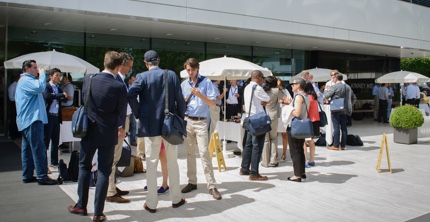
Engaging sustainability stakeholders
Stakeholder distinctions
Perhaps the most significant barrier that hinders stakeholder engagement is the varying degrees of importance that organizations pay to different stakeholder groups. One of the most notable distinctions is that of a primary stakeholder versus a secondary stakeholder. Namely, primary stakeholders are those who are directly tied to an organization through financial transactions. These include shareholders, managers, employees, customers, and suppliers. Secondary stakeholders, on the other hand, include those who are indirectly impacted by an organization or who indirectly impact an organization. These include the environment, society at large, and the communities connected to primary stakeholders. The current prioritization of stakeholder groups is further tiered than the traditional two-group characterization implies. As depicted in Figure 1, most organizations prioritize primary stakeholders over secondary stakeholders, but they make further distinctions within each category. A firm’s first charge to engage stakeholders is to abolish the mental framework depicted in Figure 1 and instead, to prioritize all stakeholders equally. Moreover, there should not be a distinction between primary stakeholders and secondary stakeholders, or between stakeholders within each grouping. Despite not sharing direct financial ties, secondary stakeholders have the same stake in an organization, as do primary stakeholders. By making all stakeholders equitable, a firm’s financial objectives will not be achieved at the expense of a firm’s social and environmental objectives.
Future-proof your organization
Equip yourself with the expertise to embed forward-thinking strategies into your organization, helping you anticipate market shifts, reduce risk, and unlock new opportunities for growth.
Rana Plaza disaster
The first step to equally prioritizing all stakeholder groups is for firms to identify who their stakeholders are. On April 24, 2013, an eight-story commercial building, Rana Plaza, collapsed in Dhaka, Bangladesh, killing 1,129 people. It was the deadliest accident in the history of the garment sector. The building, which had been purpose-built for shops and offices, was not designed for the rigors of the many factories it housed. A news story featured the day before the accident revealed cracks in the building, causing a building-wide evacuation. However, employees were informed that the building was safe and that it was all right to return the following day. Some employees were even threatened with the loss of a month’s pay if they did not come to work. On the day of the collapse, there was a power outage. Diesel generators that were started on the top floor to provide electricity are cited as the probable source of the collapse. The garment factories in Rana Plaza produced apparel for many famous brands including Walmart, Mango, United Colors of Benetton, Bonmarché, The Children’s Place, Joe Fresh, Matalan, El Corte Inglés, Monsoon Accessorize, and Primark. Most, if not all, had never heard of Rana Plaza until April 24, 2013. The larger the organization, the more difficult it is to identify every stakeholder. But it is imperative that this is done.
Find the perfect program for you.
Our diverse range of programs includes options for on-campus learning, online learning, or a hybrid/blended format combining both face-to-face and online formats.
Engaging stakeholders
After identifying stakeholder groups, the second important task is to give them a voice. Bureaucratic structures often hinder stakeholder dialogues, as many levels are created between producers and the companies who sell their products. While corporate social responsibility (CSR) reports are aimed at tracking key performance indicators (KPIs), they are a one-way street. If the apparel brands had known about Rana Plaza, would they have been able to engage with producers? This is therefore a second challenge that needs to be address, as a meaningful dialogue implies a two-way system of communication. Firms should therefore strive to understand who their stakeholders are but then engage with them to understand their precise needs.
Francisco Szekely is Sandoz Family Professor of leadership and sustainability and Director of the IMD Global Center for Sustainability Leadership (CSL). He directs Sustainability Leadership in Action (SLA), a talent development initiative targeted at leaders committed to discovering new ways to increase their performance and deliver exceptional results. Zahir Dossa is a postdoctoral fellow at the CSL. He earned a Ph.D. from MIT in Sustainable Development and is the co-founder and president of Function of Beauty.
IMD business school is an independent academic institute with close ties to business and a strong focus on impact. Through our world-leading Executive Education, Master of Business Administration (MBA), Executive MBA, and Solutions for Organizations we help leaders and policy-makers navigate complexity and change. Here at IMD, you can develop your strategic thinking skills by learning alongside senior leaders from around the world – set against the inspiring backdrop of the Swiss Alps.
Research Information & Knowledge Hub for additional information on IMD publications
Executive Programs
Upcoming Events

Businesses can showcase their commitments to nature and sustainability by using new voluntary biodiversity credits to invest in conservation actions that can be measured.

Business leaders must master the art of building strategies that take account of partisan divides over net-zero goals while progressing the interests of their company and society.

A guide to help businesses navigate the rapidly evolving voluntary biodiversity credit (VBC) markets.
This guide aims to help businesses navigate the rapidly evolving voluntary biodiversity credit (VBC) markets and decide whether and how to engage in VBCs. It is intended for companies that want to help halt biodiversity loss or restore and regener...

Rethinking sustainability at Bayer, Daniel Schneiders shows how shifting team ownership and decision-making drives lasting impact across the company.

Climate risk is financial risk and delaying action only increases costs. Despite backlash, the shift to a cleaner energy future must accelerate.

Future-ready organizations that focus on the energy transition and accelerate along with it will reap the benefits.

ABB CEO Morten Wierod on leaner cleaner strategy, electrification, automation, robotics, AI, digital transformation, sustainability, leadership.

ABB CEO Morten Wierod on leaner cleaner strategy, electrification, automation, robotics, AI, digital transformation, sustainability, leadership.

How Maersk is rewriting the rules of shipping decarbonization – through collaboration, purpose, and placing big bets on the fuels of the future.
in I by IMD
Research Information & Knowledge Hub for additional information on IMD publications
Research Information & Knowledge Hub for additional information on IMD publications
in I by IMD
Research Information & Knowledge Hub for additional information on IMD publications
IMD white paper, 23 September 2025
Research Information & Knowledge Hub for additional information on IMD publications
in I by IMD
Research Information & Knowledge Hub for additional information on IMD publications
in I by IMD
Research Information & Knowledge Hub for additional information on IMD publications
in I by IMD
Research Information & Knowledge Hub for additional information on IMD publications
Research Information & Knowledge Hub for additional information on IMD publications
Research Information & Knowledge Hub for additional information on IMD publications
Research Information & Knowledge Hub for additional information on IMD publications



